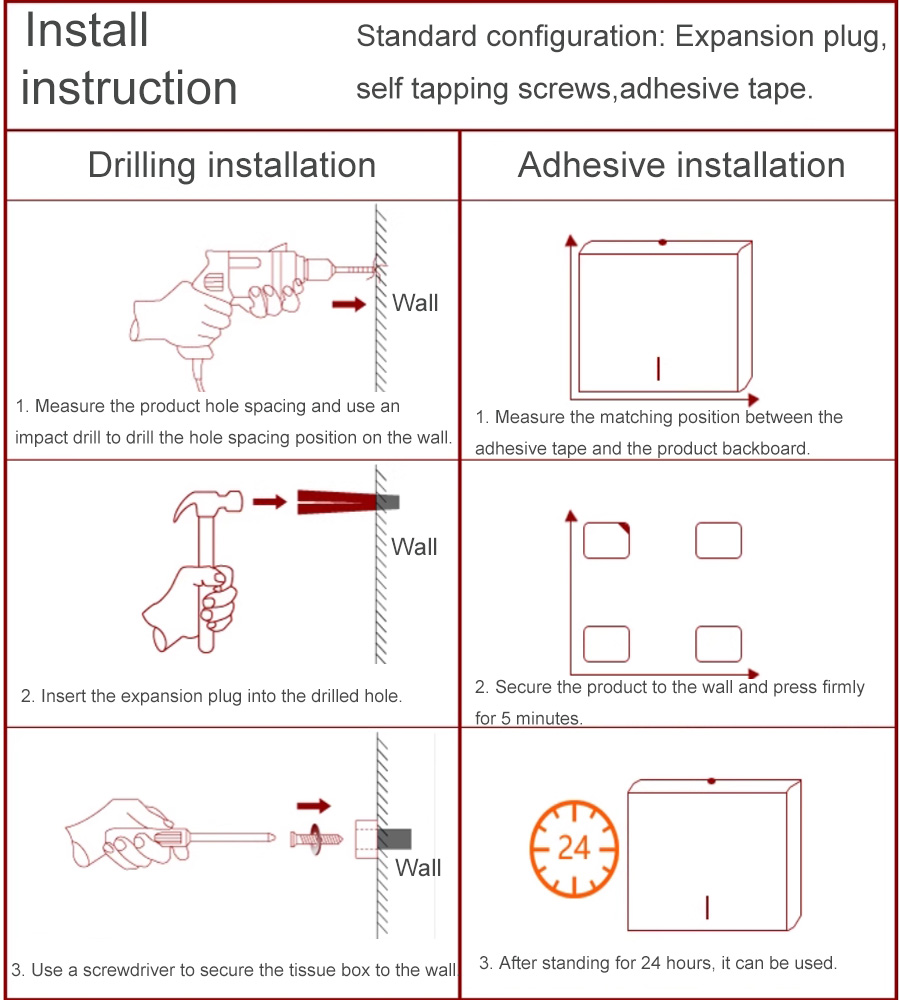What Are You Looking For?
In order to better use the waterproof stainless steel 304 tissue dispenser, let's introduce it from two aspects: installation and maintenance.
Installation:
drilling and adhesive

Core points and techniques of maintenance
1. Rust and corrosion prevention
Material maintenance:
304 stainless steel has strong corrosion resistance, but it may still be corroded by long-term exposure to strong acids and alkalis (such as bleach and toilet cleaners). If accidentally touched, it should be immediately rinsed with clean water and wiped dry.
Environmental control:
Kitchen tissue boxes should be kept away from high-temperature areas on the stove to avoid long-term attachment of oil fumes. Toilet tissue dispensers need to be kept ventilated to reduce moisture erosion. Regularly wipe the surface with a dry cloth.
2. Maintenance of hardware components
Hinges/rails:
Regularly (every 3-6 months) apply a small amount of food grade lubricant (or specialized hardware lubricant) to the hinges and drawer rails to maintain smooth opening and closing, reduce noise and wear.
Check if the screws are loose and tighten them in a timely manner to avoid sagging of the door panel or drawer.
Handle/Lock:
Wipe the surface of the handle with a dry cloth during cleaning to avoid using corrosive cleaning agents and prevent the coating from peeling off; If the lock is stuck, a small amount of graphite powder can be dripped in for lubrication.
3. Surface protection measures
Film protection: Transparent scratch resistant film can be applied to the surface (especially in high-frequency contact areas), and the film should be replaced regularly to protect the shell.
Polishing maintenance: Apply stainless steel special care agent to the surface every six months, wipe it with a soft cloth until it is shiny, form a protective film, and enhance the ability to resist dirt and rust.
3、 Targeted maintenance for different scenarios
1. Kitchen stainless steel 304 tissue dispenser
Key protection: prevent oil stains and acid and alkali (such as cleaning immediately after soy sauce or vinegar spills).
Cleaning frequency: Wipe the surface with a damp cloth daily, deeply clean once a week with a neutral cleaner, and increase the cleaning frequency near the stove with a tissue box.
Internal maintenance: Keep the interior dry.
2. Stainless steel tissue box in the bathroom
Moisture prevention key: After each use, dry the surface moisture of the counter top and box in a timely manner, install exhaust fans to maintain ventilation, and reduce scale deposition.
Sealing inspection: Regularly check whether the sealant at the connection between the cabinet and the wall is cracked, and promptly repair the sealant to prevent water vapor from seeping in.
4、 Taboos and Misconceptions Reminder
Disable cleaning tools:
❌ Rough tools such as steel wire balls, hard brushes, sandpaper, etc. can damage the surface protective layer and increase the risk of rust.
❌ Chlorine containing cleaning agents (such as 84 disinfectant) and strong acid and alkali cleaning agents can easily corrode the surface of stainless steel, causing discoloration or rusting.
Avoid prolonged humidity:
❌ After cleaning, do not dry off the moisture, especially at gaps and welds, as residual moisture can easily cause oxidation and corrosion.
Do not use incorrect maintenance products:
❌ Ordinary engine oil and lubricating oil may contain impurities. It is recommended to use specialized stainless steel care products to avoid residual oil stains from adsorbing dust.
5、 Emergency response and long-term maintenance plan
Sudden stain treatment: If liquid such as soy sauce or coffee spills, immediately use a damp cloth to absorb the liquid, and then wipe it with a neutral cleaner to avoid seeping into gaps or long-term residue.
Regular inspection cycle:
Monthly: Check the surface of the dispenser for scratches, rust, and loose hardware.
Quarterly: Deeply clean once, including internal partitions, drawer bottom plates, and apply hardware lubricant.
Every year, professional personnel are required to conduct a comprehensive inspection (such as sealing at welding points, loss of plate thickness, etc.) and promptly repair potential problems.
Through the cleaning and maintenance measures of the above system, the appearance smoothness and structural stability of the stainless steel tissue box can be effectively maintained, extending its service life and reducing later maintenance costs.